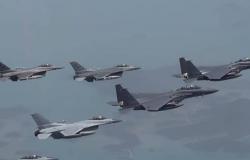It was once just the name of a fighter-bomber. Since yesterday the acronym F16 has been the symbol of a possible double escalation on the Ukrainian front. Double because the promised supply of these planes to Kiev by 4 European countries (Denmark, the Netherlands, Belgium and Norway) has a double meaning. On the one hand, it would allow Kiev to make up for the artillery’s shortcomings and strike deep into Russian territory. On the other hand, it can push Moscow to strike them in NATO skies, triggering a reaction from the Alliance. Vladimir Putin himself evokes the second scenario: “If they are used by airports of third countries, for us they will be a legitimate target, no matter where they are”, he said yesterday, recalling that the F-16s can carry nuclear weapons.
Putin does not speak at random. The first six F16s supplied by Denmark are expected at the NATO base in Fetesti, in southern Romania. There, combat training is planned for 12 Ukrainian pilots who have completed a ten-month preliminary course in Denmark, the United States and Great Britain. But training in the Romanian skies will bring the F16s close to a Ukrainian border where they could end up in the Russians’ collimator. To understand whether the threat is concrete, we need to see whether the deployment of multi-role fighters represents such a threat to Moscow as to push it to risk a direct clash with NATO. Today one would say no. Six F16s entrusted to just 12 hastily trained pilots will not make up for Kiev’s current strategic shortcomings. Even if used to hit the Russian lines of advance, they will not compensate for the lack of ammunition of an artillery capable of guaranteeing, unlike air raids, constant and continuous rates of fire. And not even incursions into the Russian rear would make a difference.
In all this, the remaining 39 of the 45 F16s promised by Denmark, the Netherlands, Belgium and Norway do not seem destined to arrive very soon. Thirteen Danish aircraft will be delivered at the end of 2024 or during 2025. The Netherlands, Belgium and Norway are moving even more slowly. The Netherlands says it will send the promised 24 planes only when Ukraine is ready to receive them. That is, when there will be pilots capable of flying them and technicians capable of ensuring their maintenance. Two not very encouraging conditions. In January none of the 12 Ukrainian pilots involved in the courses that began in August at the Danish base in Skrydstrup were still able to fly. The limited knowledge of English and the habit of flying Russian aircraft with less complex technologies than Western ones made training very problematic. It is no coincidence that the training of the next eight drivers will only begin at the end of the summer. But even more complex is the problem of maintenance that requires teams of 8/14 technicians for each individual aircraft. NATO predicts that the fifty Ukrainians chosen and trained for this purpose will not be sufficient to carry out their task independently. To resolve the most serious problems, it will therefore be necessary to decide whether to return the F16s to Europe or deploy NATO technicians to Ukraine.
With the considerable risk of turning them into targets for Russian missiles.






